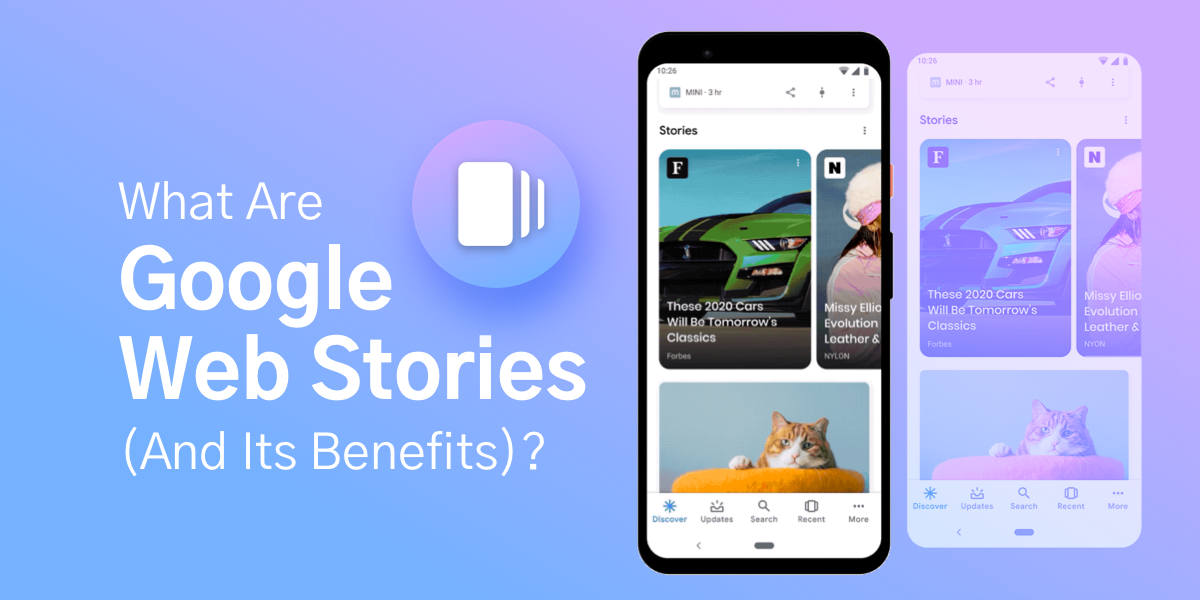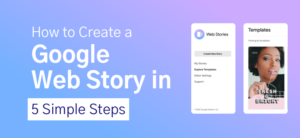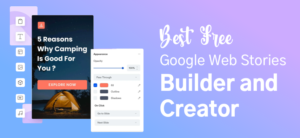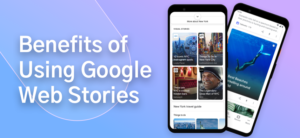What Are Google Web Stories (And Its Benefits)?
Published On
September 25, 2022
Google Web Stories are nothing but engaging, video-centric content powered by AMP technology. To put it simply, a web story is a full-screen immersive experience that you can host from your website, index later, and promote across relevant search results in a hassle-free way. You can use these stories to share useful information with your target audience in clickable page formats showcasing preferred text, audio, and images or embed them like YouTube videos or podcast episodes.
Apart from Google search results and your own website, you can explore the benefits of Google Web Stories across Google Discover and Google Images and even link them to multiple social media platforms. You can include Google AdWords and introduce brand narratives, experiential stories, live stories, polls, quizzes, and more.

After knowing the basics, it is time to understand how to create a Google Web Story. There are a few steps that you need to consider in order to make the most out of your web stories. Let’s take a look at them one by one to give you a better idea.
The first and foremost step is to prepare a crystal-clear blueprint of your brand narrative. You can use a storyboard script template for the same.
It’s important to create an outline for your story. Google also recommends giving you multiple options to create an outstanding outline suggesting what will be in each panel of the web story. There are multiple tools out there that also suggest you the best idea according to your industry niche.
When your narrative is ready, you need to pick an editor that best suits your requirements. If you have good development skills, you can integrate custom functionalities within your web story via an AMP tutorial. In case you lack the needed development skills, choosing a low-code/no-code editor can be your best bet.
A visual editor is a very useful software that also comes with a plugin or multiple online services that help publishers to create stunning web stories for your business niche. The visual editor contains a lot of readymade templates and stunning graphics by using them users can design each panel of the web story easily.
The next step is to exploit the features and functionalities of your chosen editor to create a Google Web Story that perfectly reflects your brand image and conveys the right message to your target audience.
Google offers a very simple PDF template to help with crafting your narrative that is called, Web Story – Script Template (PDF).
Follow this rule to get your web story to perform well. Name your Story. Pick a name for your story that makes sense for your keyword, but make sure it’s enticing for the reader and not only for google. It’s the first thing user see and take action on, along with your cover image and content.
You need to use the right set of tools such as AMP Test Validator or AMP test tool to verify whether your web story is AMP valid.
Use URL Inspection Tool or the Sitemaps Report to identify if your story is ready to get indexed by Google. Additionally, you also need to address and remove potential multi-platform compatibility issues.
After testing, you can move forward to publishing your Google Web Story on your preferred platforms. And last but not least, you need to keep track of user interactions and gather feedback to make necessary changes and modifications to the visual assets of your web story.
To keep your readers engaged, follow our best practices for creating Web Stories. We recommend focusing on the critical tasks first. If you have more time, follow the recommended best practices too.

There are various tools available across the market that can help you create Google Web Stories. But only a few can help you achieve desired results without compromising on quality.
The list is not limited to but includes the following.
1. Google Web Stories Plugin: It can be your go-to option to build and publish intuitive web stories for WordPress. It is a typical editor that comprises a drag-and-drop builder, exclusive templates, and customizable options with added provision to explore assets from your WordPress Media Library.
2. Product Stories: It is a one-of-a-kind tool that has the potential to create beautiful web stories and AMP pages for your products. It is easy to use, compatible with multiple mobile devices and can simplify the process of building AMP Story Widgets.
3. Newsroom AI: Another feature-rich tool is Newsroom AI, which helps you embed desired web stories on Google as well as your own website. You can easily track the performance of your stories with its robust reporting mechanism.
4. Make Stories: It is a tool that gives you a read-to-go environment with its built-in templates, user-friendly features, comprehensive catalogue (symbols, images, icons, etc.), drag-and-drop interface, WordPress integration, and more.
5. StorifyMe: StorifyMe can satisfy diverse use cases with its social media integration capabilities. It is a perfect platform to create, distribute, and track your web stories. Some of its key attributes include limitless sharing & linking and A/B testing.
6. Ampstor: It is an open-source platform to build engaging Google Web Stories with a quick turnaround time. It consists of a range of ready-to-use templates and dynamic features. What makes it more important is that it is compatible with various mobile devices and operating systems.

Adopting Google Web Stories can introduce your business to an array of benefits and help you generate profitable outcomes in the long run. Let’s take a look at some of them to understand the importance of these stories in today’s digital age.
1. Better Control: Unlike stories hosted on Snapchat and Instagram where the performance of your content depends on how these platforms function in particular, Google Web Stories can be hosted on your website and easily regulated.
2. Extended Reach: With the right creation and implementation of Google Web Stories, you can maximize your brand reach and even increase your presence across various social media platforms.
3. Fully Customizable: Google Web Stories are completely customizable and this gives enough flexibility to deliver content that fulfills your business requirements and user expectations.
4. Immersive Experiences: You can deliver larger-than-life screen experiences to both mobile as well as desktop users and help them interact with your products and services in a better manner.
5. Easy to Make: Google Web Stories are easy to build. You don’t need to acquire any specific technical skills or coding knowledge to create a market-fit web story.
6. Explore Opportunities: You can easily integrate your Google Web Stories to SEO best practices, Google AdWords, and other advertising opportunities and improve your search results accordingly.
If you want to define the true essence of visual storytelling then leveraging Google Web Stories can help you stand out. It will increase your website traffic, expand your online reputation, and improve your monetization capabilities like never before.
Google web stories are rich, engaging content formats that help businesses in many ways. Bran can benefit immensely via Google web stories including immense search and discover functionality that is worth exploring.
If you are planning to create such stories for your brand but are unable to get the needed headstart, you can outsource your business requirements to the digital marketing experts at Absolute Search Media and convert your vision into an epic reality right away!

Get In Touch With Our Team And Experience A Smarter Approach To Digital Marketing.